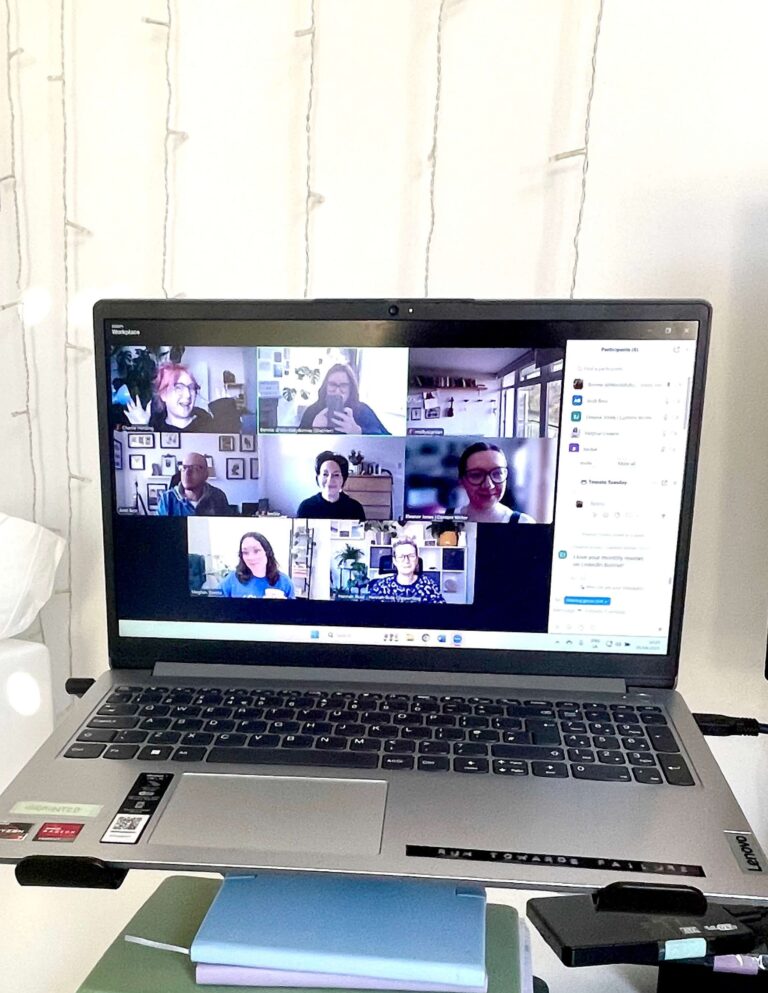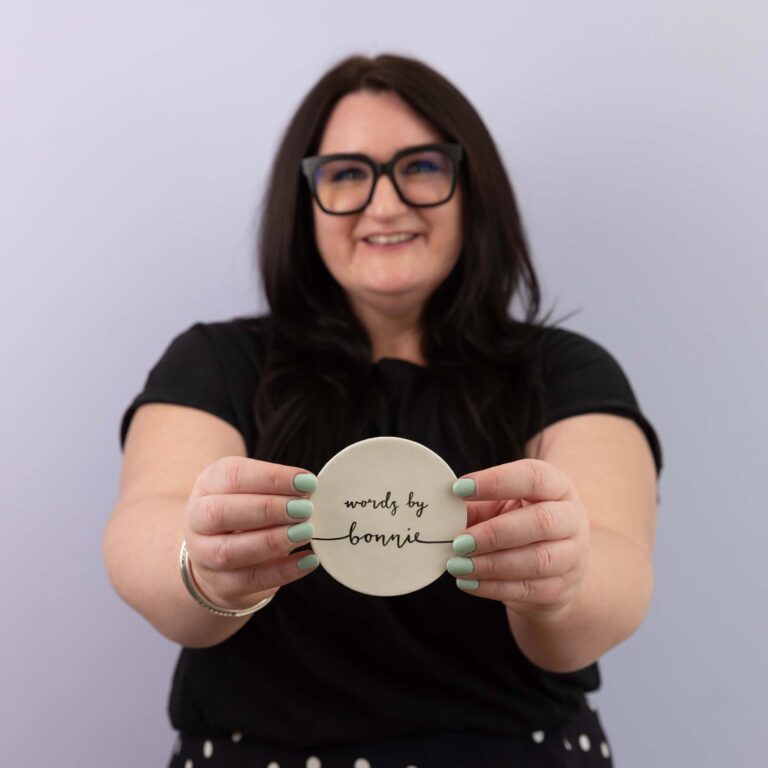After copywriting full time ‘for just shy of half… [a] decade*’, I’ve written a lot of stuff and I’ve read a lot of stuff.
I’ve gathered everything I’ve learned about copywriting into these 5 golden rules.
These rules will be helpful if you’re going to attempt your own copywriting, or if you’re considering becoming a copywriter.
These probably won’t be helpful if you’re already a copywriter, since I bet you already know the rules.
(*Yes, this is a slightly amended Schmidt from New Girl quote. I love New Girl, and there usually quotes floating around my head ‘all day’.)
Do the golden rules in that blue box up there look a bit simple? Fear not! I’ve fully explained them with a bunch of examples below.
Dive in.
Copywriting Golden Rule 1: Forget what you’ve been told about ‘good’ writing
Think about what ‘good writing’ is for a second.
Has a classic novel, like Jane Eyre, popped into your mind? Perhaps you thought of a great film (Die Hard). Songs can be ‘good writing’, you’ve heard ‘‘All Too Well’ (10- Minute Version) (Taylor’s version)’. Maybe a journalist came to mind, or even a memorable article (like ‘What happened to me was nothing’).
These are undeniable examples of (extremely) good writing. But, none of them are good copywriting.
You’ve written thousands of things in your life. Emails, letters, CVs, birthday cards, short stories, essays, Instagram captions, shopping lists, abandoned novels, journals, perhaps even eulogies.
Copywriting is like nothing you’ve ever written before.
It’s a deliberate, specialist way of writing. It is as much about psychology as it is creativity.
Copywriting is:
- Not about sounding clever, even though good copy is often clever.
- Not about conveying information, even though good copy is often informative.
- Not about entertainment, even though good copy can be brilliant and funny.
Good copywriting, simply, gets a result. An action, a payment, a follow, a sign up, a share.
That’s how you know if it’s good.

Copywriting Golden Rule 2: Your first job is to make the reader feel something
Converting a reader to a customer means you’ve inspired them to act. And, action starts with emotion.
‘Negative emotions’
It’s very effective to target “negative” emotions in copy. I do not advocate for this. Using a reader’s sadness, fear, anger, jealousy, or hatred is powerful. It’s why propaganda works so well.
You’ve seen this kind of copywriting before. It can subtly push the reader into hating a part of their body, before offering a product which “fixes” it. It will create false urgency to make the reader act impulsively, regardless of their budget.
Copywriting which taps into these emotions is agitating, and disruptive, and it works. It manipulates and heightens the reader’s existing emotions for the brand’s financial gain. This can easily become very unethical, and you won’t find me writing in this way.
‘Positive emotions’
By creating a positive feeling with your copy, you’ll still convert readers to customers.
It’s unlikely to be an instant conversion; those positive feelings need time to grow and deepen. Instead of a knee- jerk action inspired by negativity, positive copy inspires a warmer, more loyal relationship between brand and customer.
Here’s an example: selling a beauty product. Rather than “fixing” a body part or making the reader dislike their appearance, find a positive angle.
The product might be luxurious, or invigorating, or restorative. The user might feel pampered when they use it, or more ‘themselves’, or more confident. The product might be fun to use or calming to smell.
Highlighting the positives might inspire your reader to feel:
- Grateful there’s a solution
- Impressed if it’s innovative or well- designed
- Relieved they can solve their problem
- Happy to buy or sign up
- Excited to use it
- Understood and included by you
- They can trust you because you’re an expert
Authentic, positive copy allows the reader to make the right decision for them. It’s all about presenting information honestly, clearly, and without manipulative tactics.

Copywriting Golden Rule 3: Your second job is to make the reader act
‘But I’ve already got them feeling warm and fuzzy!’ I hear you cry. ‘There’s more?!’
Yep.
But this bit is easier, I promise. If your reader is feeling subtle, vaguely positive feelings, you’re already on your way to conversion.
They just need clear direction on what to do next. The best Calls to Action (CTAs) are short: ‘buy here’, ‘add to cart’, ‘join us here’, ‘your email address here’, ‘get discount’, ‘send to a pal’.
Try to keep your CTAs on brand, straightforward, and, please, make sure your links and buttons go where you want them to.

Copywriting Golden Rule 4: Always use the most simple language
Keeping the language in your copy as simple as possible is very important. Simple copy lowers the barriers to your reader understanding your product and you.
Don’t believe me? Lemme bombard you with a bunch of research and links all confirming what I just wrote.
Low literacy levels
More people than you might think struggle with reading:
- ‘Half of all adults in the UK don’t read regularly’, The Reading Agency, 2024
- ‘1 in 6 UK adults (8.5 million) struggle to read at all’, The Reading Agency, 2024
- ‘In England, 16.4% of adults are described as having “very poor literacy skills”’, National Literacy Trust
Simple language helps people who struggle with literacy. Typically, they can read and understand short texts on straightforward topics from everyday sources.
Everyday vocabulary only
On- brand vocab and SEO keywords are important, but never at the expense of clarity. Write how you speak. There’s just no point in trying to sound clever or use “big words”. You won’t appear impressive, you’re more likely to confuse and alienate.
💚 Bright and colourful
⛔Kaleidoscopic, multihued, polychromatic, opalescent, psychedelic, nacreous
💚Fast and efficient
⛔Fruitful, cogent, efficacious, adroitly, assiduously, fastidiously, irreproachably
💚Transform and improve
⛔Metamorphose, regenerate, reengineer, catalytic, remediate, ameliorate
Accessibility is non- negotiable
Aside from literacy difficulties, the simpler your language, the more accessible it is. Good copy is accessible to everyone, including people with a range of disabilities. Something seemingly small, like clearly explaining acronyms, can support neurodiverse people and those who use screen readers.
Want to know more about accessibility online? Here are the Web Content Accessibility Guidelines and Mailchimp’s Writing for Accessibility.
Simple language helps everyone
Sleep- deprived parents, people with stressful jobs, elderly people navigating the internet, students with looming deadlines… Everyone you know wants simplicity. The faster readers can get the answers they want, the better.
Regardless of industry or educational level, ‘professionals want clear, concise information devoid of unnecessary jargon or complex terms. Plain language benefits both consumers and organizations’, Nielsen Norman Group.
Generally, use short, clear sentences. Aim for one piece of information per sentence. Stick to one idea per paragraph, with all the sentences in that paragraph about that one idea.
Good copywriting is scannable
“Scannable” means someone can run their eyes quickly over the words looking for specific phrases. According to the Nielsen Norman Group, ‘people… scan the webpage, picking out individual words and sentences’ rather than reading every single word in order.
- Someone wondering how much something costs might scan for the word “sale”, or numbers, or a pound sign (£)
- Someone wondering about delivery location will look for “delivery”, “UK”, or “Bristol”
- Someone wondering if I write blogs as well as website copy will scan for the heading “blogging”
Are you worried by making your copy scannable, you’re “dumbing it down”? You’re not, I promise.
There are plenty of resources online bursting with complex detail (like this page all about boilers from British Gas). As long as the pages are formatted well everyone can scan and absorb the content.
Formatting presents your copy in the most useful way. It allows readers to jump to the part which they are most interested in. The faster you answer your readers’ questions, the faster you move them towards their decision to buy or not.
Connect with everyone by using headings, bold and highlighted words, consistent language, and bullet points.

Copywriting Golden Rule 5: Focus entirely on your reader, not on yourself
Good copywriting entirely centres the reader. This can be quite hard for new copywriters and business owners to get to grips with. After all, you’re the expert, it’s your product/ service, it’s your website… surely you should be writing all about yourself?!
Nope.
Good copywriting, as much as possible, is about your reader and their needs.
How well do you know your audience?
This can get complicated- with buyer personas and lots of research- but start simple. In your copy, think about who you want to sell to and what they need/want.
Do they want speed, luxury, efficiency, ease, fun, status? Work it out and emphasise it.
Here are three examples:
- You’re selling a highchair for babies so you’re writing to parents. Parents will want mealtimes to be stress free and easy. That’s the angle for your copy. They might also be cost- conscious, especially if they’re on parental leave. Emphasising value for money is a good idea. Safety is absolute essential, so include this.
- You’re an HR Consultancy so you’re selling to business leaders. There’s no point in telling them all the technical details of employment law. You care about that. The business owner does not. They’ll care about how your service boosts their profits, helps them meet targets, and improves staff retention. Concentrate on that.
- You sell an app which supports people to invest in sustainable funds. Yes, sharing your environmental ambitions, and writing about climate change is important. But, ultimately, your audience cares about making money. That’s why they’re investing. They want to know how and why they can trust you to make them richer. That’s it.
Delete ‘I’/ ‘my’ or ‘we’/ ‘us’/ ‘our’
Removing all first person/ first person plural references is tricky, but good copy has as few as possible.
It’s sad but true: we’re all thinking about ourselves, all the time. We’re not super interested in other people beyond how they impact us. (I know, depressing, right?)
‘In his classic book Scientific Advertising, Hopkins wrote: “Remember the people you address are selfish, as we all are. They care nothing about your interests or profit. They seek service for themselves. Ignoring this fact is a common mistake and a costly mistake.”’ The Yardstick Agency.
Here’s how to centre your reader.
- ‘Driving traffic to your website with SEO blogs is my jam’ is much better than ‘I’m really good at writing blogs’.
- ‘Hate writing? Let me take care of that for you’ is better than ‘I was an English teacher for 10 years’.
- ‘The copywriting your small biz needs’ is better than ‘my copywriting services’.
What does your reader actually need to know?
Even your about page is not about you. It’s about what your reader needs to know about you.
Sure, include a short, fun story which proves your values or skills. Add a little anecdote about why you started your business. These are great little insights!
Do not tell your audience anything irrelevant. The UK Government: Content Design Guidance states “do not publish everything you can online. Publish only what someone needs to know so they can complete their task. Nothing more”.
Your readers don’t need to know about your childhood, or your hobbies, or how you parent, or your health, unless it’s directly linked to your business.
Often, business owners want to write as much as possible. They think, “the more informed my reader is, the more I can convince them”. This could not be further from the truth. Readers need just the right amount of information to take the next step towards buying. Anything else is a distraction.
That’s it! My 5 golden rules of copywriting. Hopefully now you’re equipped to tackle your own copywriting. Or you’re at least clearer on what “good” copywriting is.
If you’d rather I just wrote your copy for you, pop your details in this form right here.
Copywriters: did I miss anything? What are your golden rules? Let me know! Bonnie@wordsbybonnie.com








